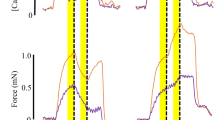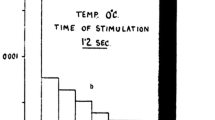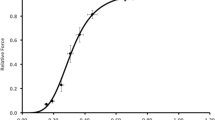Summary
The primary objective of this study was to determine if the rate limiting step in the crossbridge cycle was the same during maximum rate of shortening and during maintenance of maximum tension in an isometric contraction. To this end the temperature dependence,Q 10, of the crossbridge cycle was estimated during unloaded shortening and maximum isometric tetanus. Isolated semitendinosus muscles from the frog were studied at 0 and 10° C. Crossbridge cycling during unloaded shortening was determined from the velocity of unloaded shortening estimated by the slack step technique. Crossbridge cycling during maintained isometric tetanus was determined from the steady rate of energy liberation during the tetanus after allowance for energy liberation due to Ca2+ cycling. TheQ 10 of the velocity of unloaded shortening was 2.5 and that of the steady rate of energy liberation was 4.6. After correction for the temperature dependence of energy liberation associated with Ca2+ cycling (5.7), the estimatedQ 10 of the steady rate of energy liberation became 3.9. These estimates of theQw of the crossbridge cycle are significantly different. These results support the conclusion that the rate limiting steps during unloaded shortening and maximum isometric force maintenance occur at different steps in the crossbridge cycle. Further the high Q10 of the energy liberation due to Ca2+ cycling may relate to the high concentration of parvalbumin in frog muscle. A second objective of this study was to document in the same muscle the variation of Q10s of mechanical and energetic properties of contraction. Over this temperature range the Q10s ranged from 1.1 to 5.7.
Similar content being viewed by others
References
Aubert, X. (1956)Le Couplage Energetique de la Contraction Musculaire. Brussels: Editions Arscia.
Barany, M. (1967) ATPase activity of myosin correlated with speed of muscle shortening.J. gen. Physiol. 50, 197–218.
Barouch, W. w. &Moos, C. (1971) Effect of temperature on actin activation of heavy meromyosin ATPase.Biochim. biophys. Acta. 234, 183–9.
Bressler, B. H. (1981) Isometric contractile properties and instantaneous stiffness of amphibian skeletal muscle in the temperature range from 0 to 20° C.Can. J. Physiol. Pharmac. 59, 548–54.
Curtin, N. A. &Woledge, R. C. (1979) Chemical change and energy production during contraction of frog muscle: how are their time courses related?J. Physiol., Lond. 288, 353–66.
Curtin, N. A. &Woledge, R. C. (1981) Effect of muscle length on energy balance in frog skeletal muscle.J. Physiol., Lond. 316, 453–68.
Edman, K. A. P. (1979) The velocity of unloaded shortening and its relation to sarcomere length and isometric force in vertebrate muscle fibres.J. Physiol.,Lond. 291, 143–59.
Ford, L. E., Huxley, A. F. &Simmons, R. M. (1977) Tension responses to sudden length change in stimulated frog muscle fibres near slack length.J. Physiol., Lond. 269, 441–515.
Ford, L. E., Huxley, A. F. &Simmons, R. M. (1981) The relation between stiffness and filament overlap in stimulated frog muscle fibres.J. Physiol., Lond. 311, 219–49.
Gillis, J. M., Thomason, D., LeFevre, J. &Kretsinger, R. H. (1984) Formation of calcium-parvalbumin complex during contraction. A source of “unexplained heat”? InContractile Mechanisms in Muscle (edited byPollack, G. H. andSugi, H.), pp. 573–9. New York: Plenum Press.
Gordon, A. M., Huxley, A. F. &Julian, F. J. (1966) The variation in isometric tension with sarcomere length in vertebrate muscle fibres.J. Physiol., Lond. 184, 170–92.
Homsher, E., Kean, C. J., Wallner, A. &Sarian Garbian, V. (1979) The time course of energy balance in an isometric tetanus.J. gen. Physiol. 73, 553–67.
Homsher, E., Mommaerts, W. F. H. M., Ricchiuti, N. V. &Wallner, A. (1972) Activation heat, activation metabolism and tension-related heat in frog semitendinosus.J. Physiol., Lond. 220, 601–25.
Homsher, E. &Rall, J. A. (1973) Energetics of shortening muscles in twitches and tetanic contractions. I. A reinvestigation of Hill's concept of shortening heat.J. gen. Physiol. 62, 663–76.
Huxley, A. F. (1957) Muscle structure and theories of contraction.Prog. Biophys. Chem. 7 255–318.
Huxley, H. E. (1969) Theory of muscle contraction.Science,N.Y. 164, 1356–66.
Kean, C. &Homsher, E. (1974) The effect of temperature on the maintenance heat rate and maximum shortening velocity of frog skeletal muscle.Fedn Proc. Fedn Am. Socs exp. Biol. 33, 1334.
Rall, J. A. (1979) Effects of temperature on tension, tension-dependent heat, and activation heat in twitches of frog skeletal muscle.J. Physiol., Lond. 291, 265–75.
Reiser, P. J., Stokes, B. T. &Rall, J. A. (1982) Isometric contractile properties and velocity of shortening during avian myogenesis.Am. J. Physiol. 243, C177–83.
Rüegg, J. C. (1971) Smooth muscle tone.Physiol Rev. 51, 201–48.
Smith, I. C. H. (1972) Energetics of activation in frog and toad muscle.J. Physiol., Lond. 220, 585–99.
Author information
Authors and Affiliations
Rights and permissions
About this article
Cite this article
Burchfield, D.M., Rall, J.A. Temperature dependence of the crossbridge cycle during unloaded shortening and maximum isometric tetanus in frog skeletal muscle. J Muscle Res Cell Motil 7, 320–326 (1986). https://doi.org/10.1007/BF01753652
Received:
Revised:
Issue Date:
DOI: https://doi.org/10.1007/BF01753652




